Although I have always loved Italian, learning the language really became important to me after my daughter met and married an Italian man while working in Torino, Italy. When we first met him his knowledge of the English language was already impressive and since living here in the U.K., he has achieved fluency. At the same time, my daughter has become a highly proficient Italian speaker and they are now passing on their love of the language to their young son.
I felt it essential, therefore, to achieve a better understanding of the Italian language in order to communicate with my son-in-law’s family in Italy when I visit them again. I also feel that, if I am visiting them in their country, I should make an attempt to speak their language rather than force them to speak English. I would also like to encourage my grandson as he becomes a more fluent Italian speaker. At the moment, at the age of 2 and a half, he is streaks ahead of me in his understanding and communication but I plan to remedy that!
At school, I studied French and some Latin, but the teachers emphasised grammar to the detriment of communication and I can’t remember the lessons being very enjoyable. When I started studying Italian seriously a little over a year ago, I knew I wanted to take a completely different approach to the traditional methods of study, which is why I opted for Duolingo.
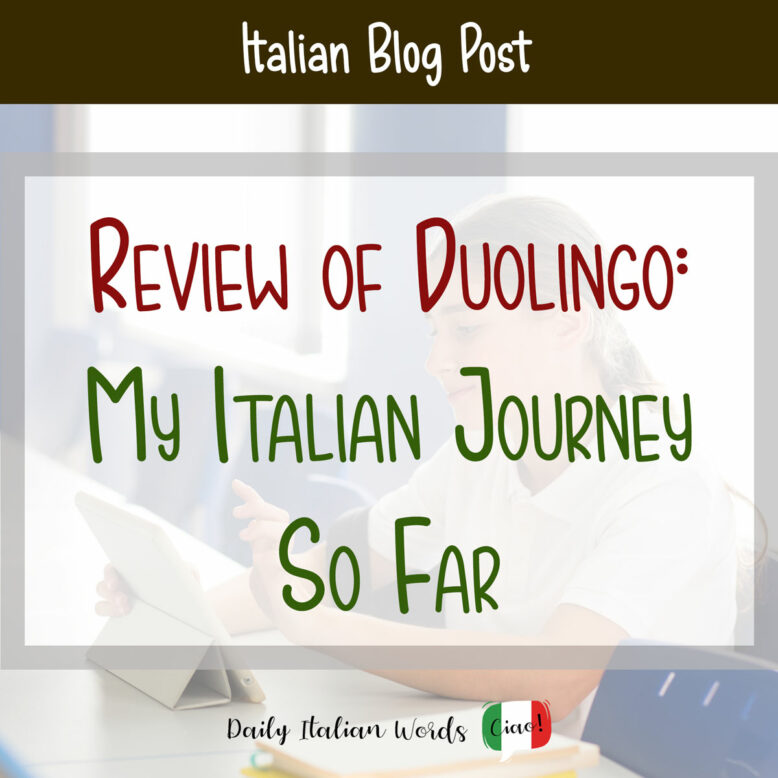
Why Duolingo?
To be completely honest, I became attracted to Duolingo for two reasons: it is free, and it is fun.
The lessons can be completed in minutes and they look appealing with their colourful animated characters, most notably the iconic green owl. Each character represents a native Italian speaker: a male, a female and a child who read out the sentences. I find this is a positive way of getting our ears attuned to various Italian voices – although I do find the gruff older gentleman’s voice a bit difficult to understand at times!
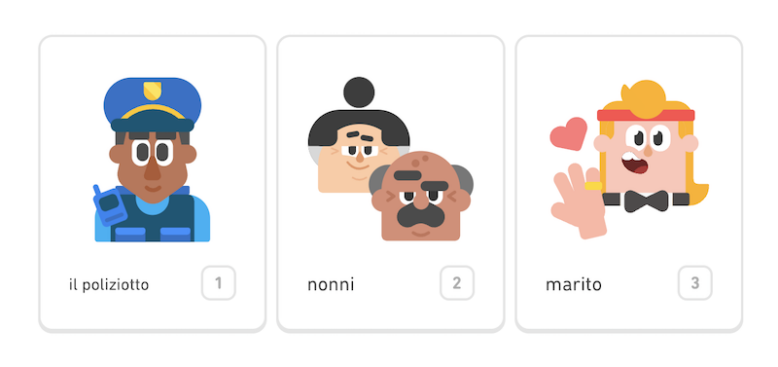
Duolingo vs Super Duolingo
The downside to not paying for Super Duolingo (formally known as Duolingo Plus) is the necessity to watch advertisements which appear at the beginning and end of each lesson. However, most of the ads only last a few seconds, 30 at most, so it is easy to walk away, make a cup of tea, then return to start another lesson, if you so choose. You are also only allowed a certain number of mistakes before you are timed out. The time-outs usually last four hours.
Were I to sign up to Super Duolingo, I would be allowed unlimited mistakes, the possibility to track my progress, and access to lessons offline. However, for my purposes, the free version works just fine.
Note: If you are interested in giving it a try, Duolingo does offer a two-week free trial.
How to Use Duolingo
Most of the exercises on Duolingo require you to simply translate from English to Italian and vice versa. Here are some of the most common ones that you will encounter as you progress through the course:
‘Tap What You Hear’
This exercise involves inserting the correct words in the blank space. You do have to listen carefully because the difference in pronunciation of some words can be very subtle.
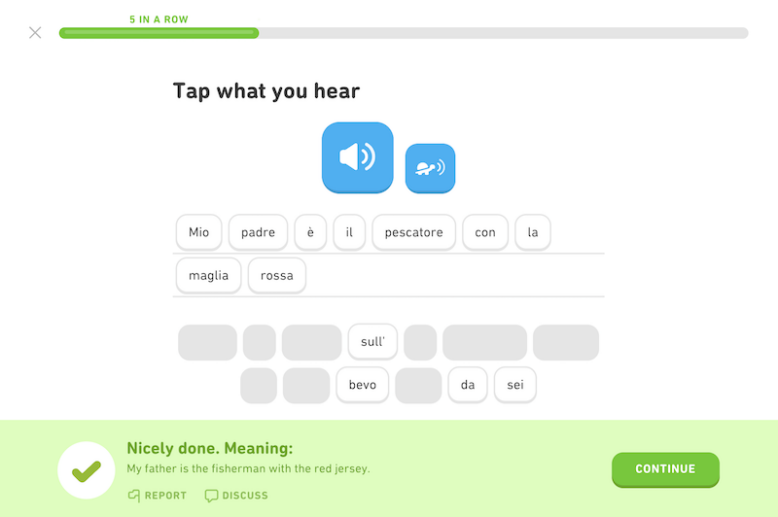
‘Select The Matching Pairs’
This exercise requires you to listen and tap the correct pairing. Five English words must be paired with five Italian words from the neighbouring column.
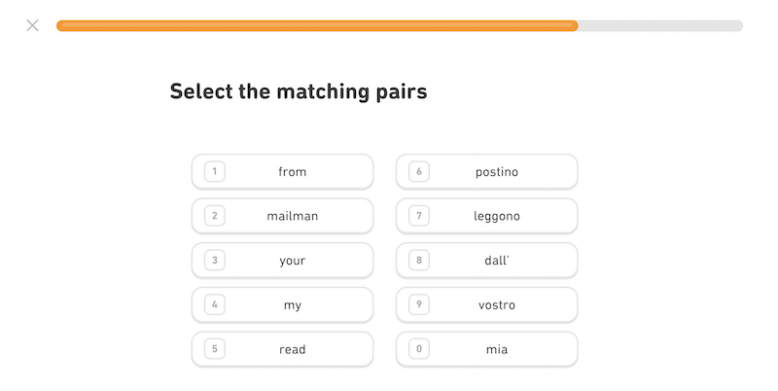
‘Translate this sentence – Italian to English’
This section is pretty self-explanatory – simply translate the Italian phrase into English using the available words. Not all the words are required to make the sentence; some are completely redundant and are only there to throw you off.
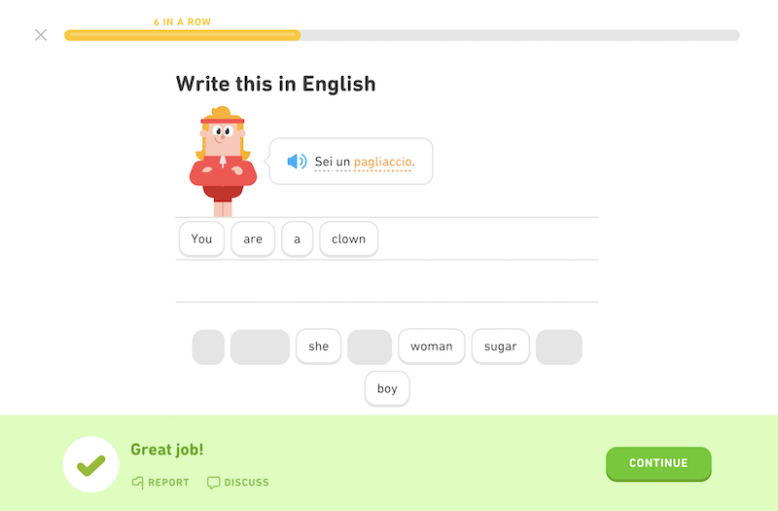
‘Translate this sentence – English to Italian’
Here you are given an English sentence and you must tap a series of Italian words to form the correct sentence. For example:
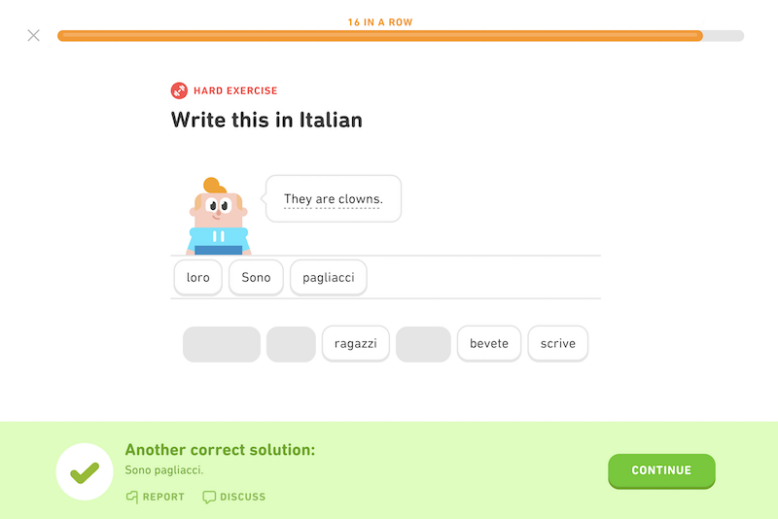
‘Speak this sentence’
If you enable your microphone, you can tap the ‘Click to Speak’ icon to record yourself speaking the Italian sentence given. The words turn blue if pronounced correctly – although I have noticed that it will usually accept my pronunciation even if it isn’t spot on!

‘Multiple choice’
Here you must pick the correct translations from the three words provided.
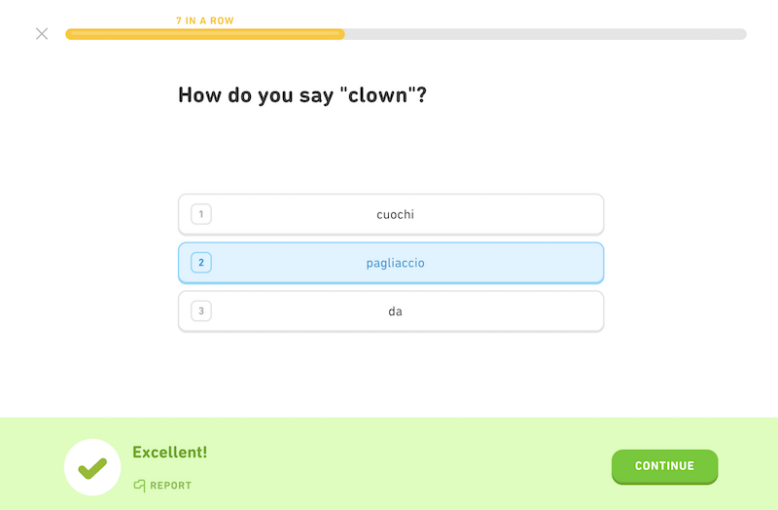
Whenever I complete a lesson, I make a note of my mistakes on a piece of paper (very old-school, I know) but I discovered that, if you click on the ‘dumb-bell’ icon, Duolingo keeps a record of all your mistakes which you can revisit at any time.
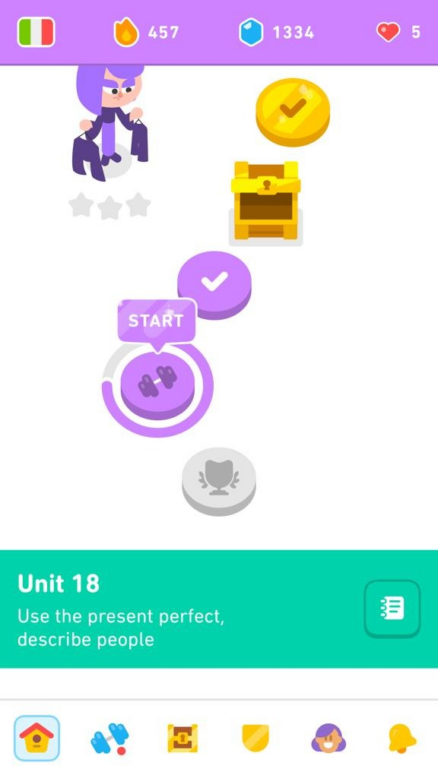
Each unit covers various topics and consists of several lessons that become more challenging as you progress through them. After completing several units and listening to a few stories you progress to a new level. There are 51 units in total consisting of 5 levels each, along with 66 skills (i.e. specific topics such as questions, adverbs, etc.) and four course sections.
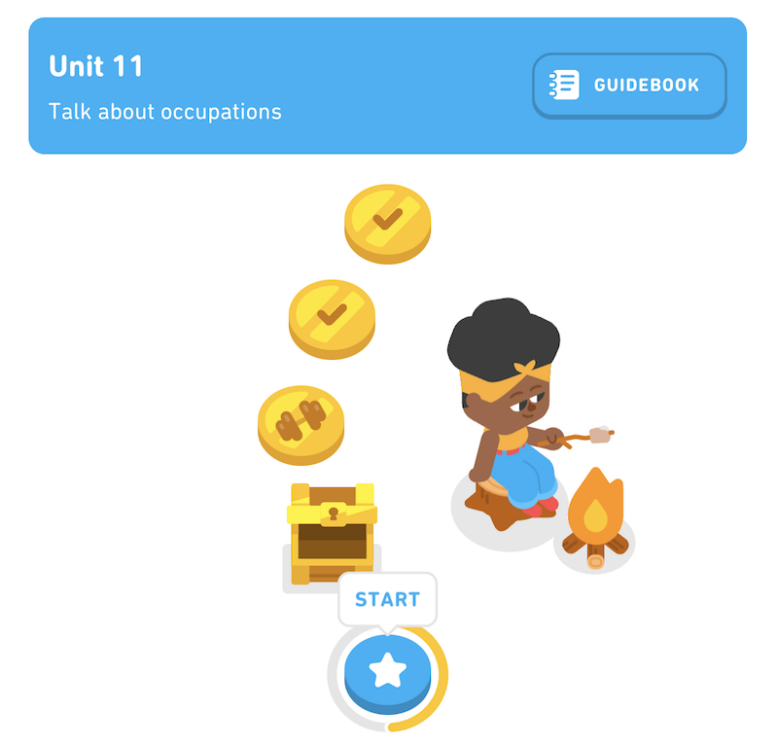
The stories are dialogues that aren’t the most thought provoking but they are fun: you have to answer ‘yes’ or ‘no’ to the questions at the end of each story. Again the dialogues help to attune your ear to natural Italian speech.
Duolingo also introduces fundamental grammar and new vocabulary in the ‘Tips’ section at the beginning of each lesson. It is important not to ignore this section because it is very helpful to help you understand and master each unit.
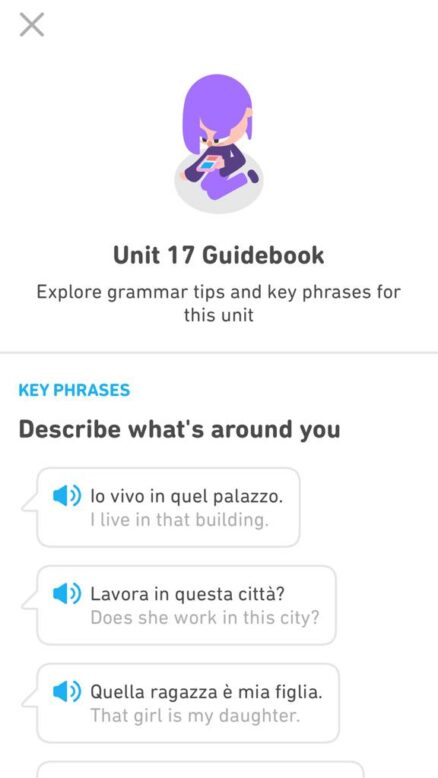
As you progress, you also receive experience points (XP) as a way of keeping you motivated. You can set a daily goal of XP you want to attain and compete with other users for a position on the XP leaderboard.
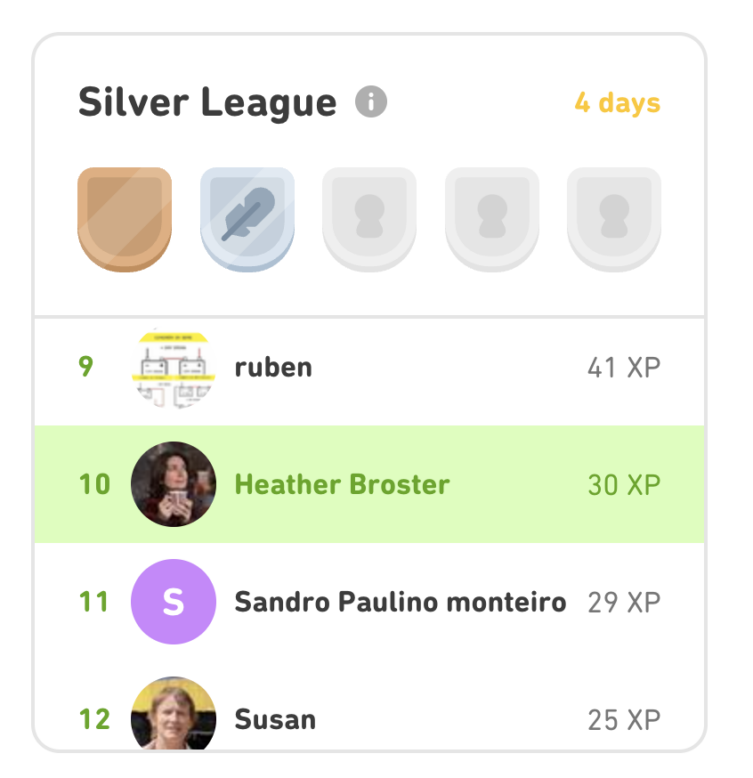
Whenever you complete a lesson, you will also receive Lingots (known as Gems on mobile), which is Duolingo’s virtual currency. You can use Lingots to buy a variety of app features, such as a streak freeze, heart refill, and streak wagers.

Duolingo also encourages you to maintain a learning streak. If you skip a day, your streak will reset. My current streak is 456 days but some of the most committed users have a streak of over 2000 days!

You also have the option of taking part in virtual meetings which are held every day, allowing you to talk to Italian learners all over the world.
What would I change about Duolingo?
Given that Duolingo is mostly run by volunteer contributors, not everything about it is perfect. For example, you may come across the occasional phrase that isn’t grammatically correct. One that surprised me in particular was the translation for “I am from England”: instead of choosing Sono inglese or Vengo dall’Inghilterra, they opted for Sono dell’Inghilterra* which sounds unnatural in Italian.
I also find some of the sentences unpractical for day-to day use. At one point, I was asked to translate the absurd phrase “Are my shoes electric?” into Italian. Unless they have developed some kind of new footwear in Italy that I’m not aware of, I doubt I’ll ever use this phrase in my lifetime!
I was also a little disappointed to discover that podcasts are offered in the French and Spanish versions of Duolingo but not Italian. Hopefully these will be offered in the future.
Finally, as helpful as Duolingo is for memorising new phrases and vocabulary, listening and reading, the app itself doesn’t help you much with speaking. For that, you will need to seek the help of native speakers, either by making use of Duolingo’s Classes, or by using external platforms like italki.
Conclusion
At the moment, I will continue studying Italian with Duolingo in the same manner as I have for over a year now as it suits my lifestyle but I realise that just studying Duolingo everyday isn’t going to make me a confident speaker.
Duolingo is an excellent accompaniment but reading in Italian, engaging in conversation with native speakers, and watching films in Italian will speed up the learning process.
I am planning a long stay in Italy in the spring. My hope is that I will be able to have a rudimentary conversation with my new Italian family. I already know that I have increased my vocabulary and that I am understanding much more since starting to study with Duolingo so we will see how I cope. I’ll keep you posted. Ciao for now!
Pros of Duolingo
– most features are free
– fun and visually appealing
– easy to complete a lesson in just a few minutes per day
Cons of Duolingo
– podcasts aren’t available
– some of the sentences are strange and unpractical
– you may come across the occasional grammatical error
Christine is a retired Library Technician and a lover of foreign cultures and languages. She was especially attracted to learning Italian because of the music, the culture, the food and her extended Italian family. Living in Wales, she has also been embracing the beautiful Welsh language which she is studying with Duolingo and making great progress.
Heather Broster is a graduate with honours in linguistics from the University of Western Ontario. She is an aspiring polyglot, proficient in English and Italian, as well as Japanese, Welsh, and French to varying degrees of fluency. Originally from Toronto, Heather has resided in various countries, notably Italy for a period of six years. Her primary focus lies in the fields of language acquisition, education, and bilingual instruction.


